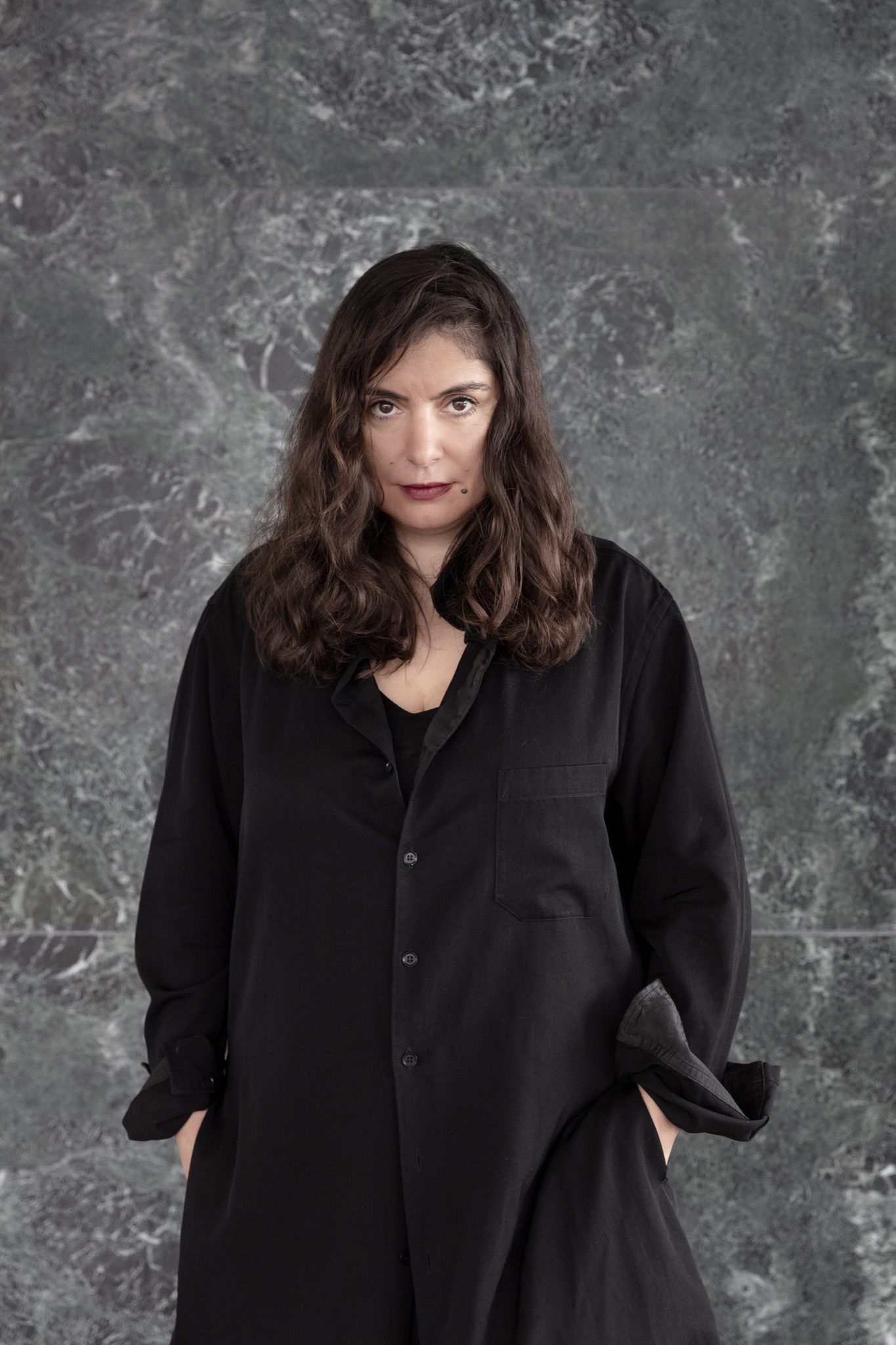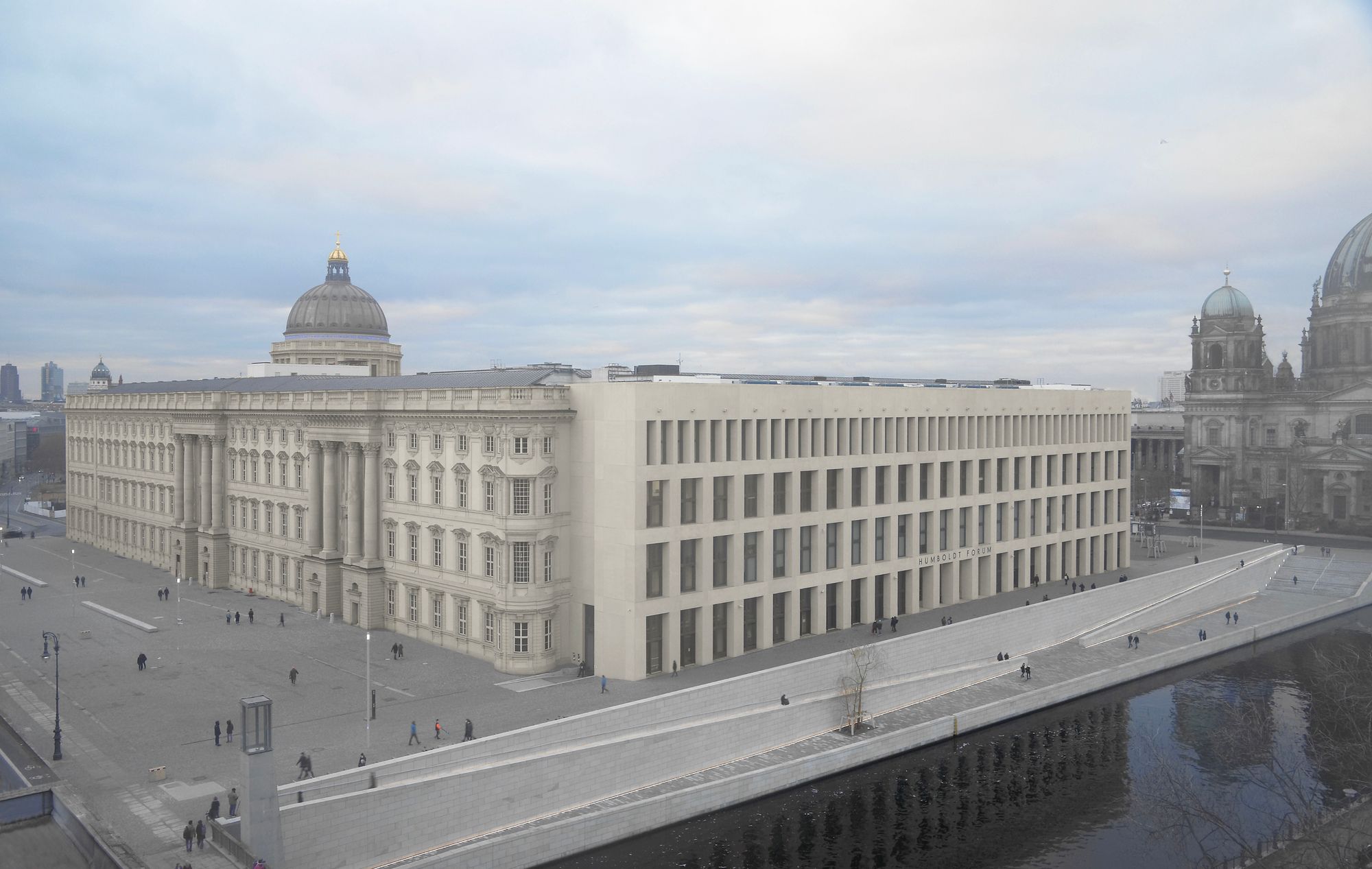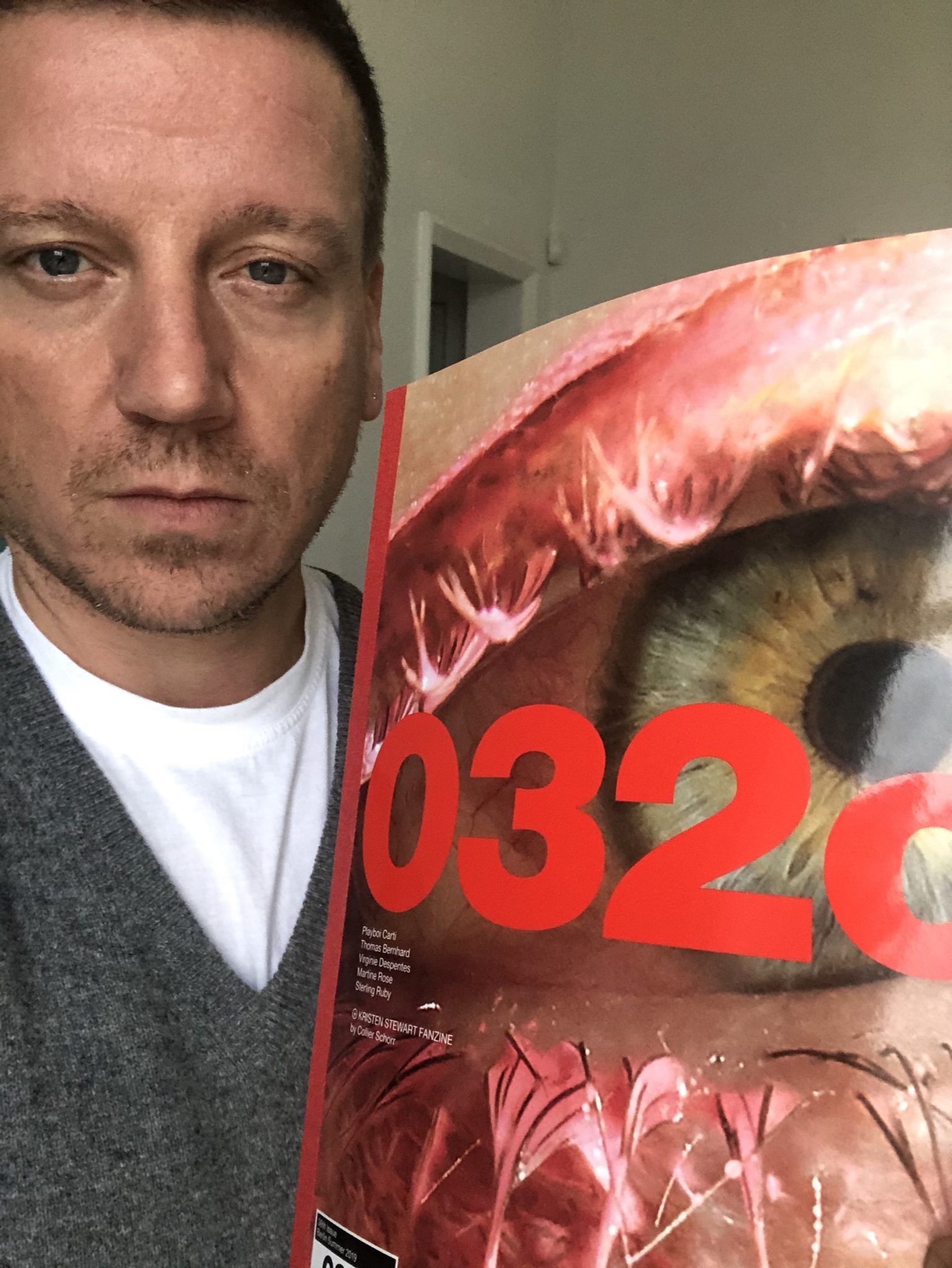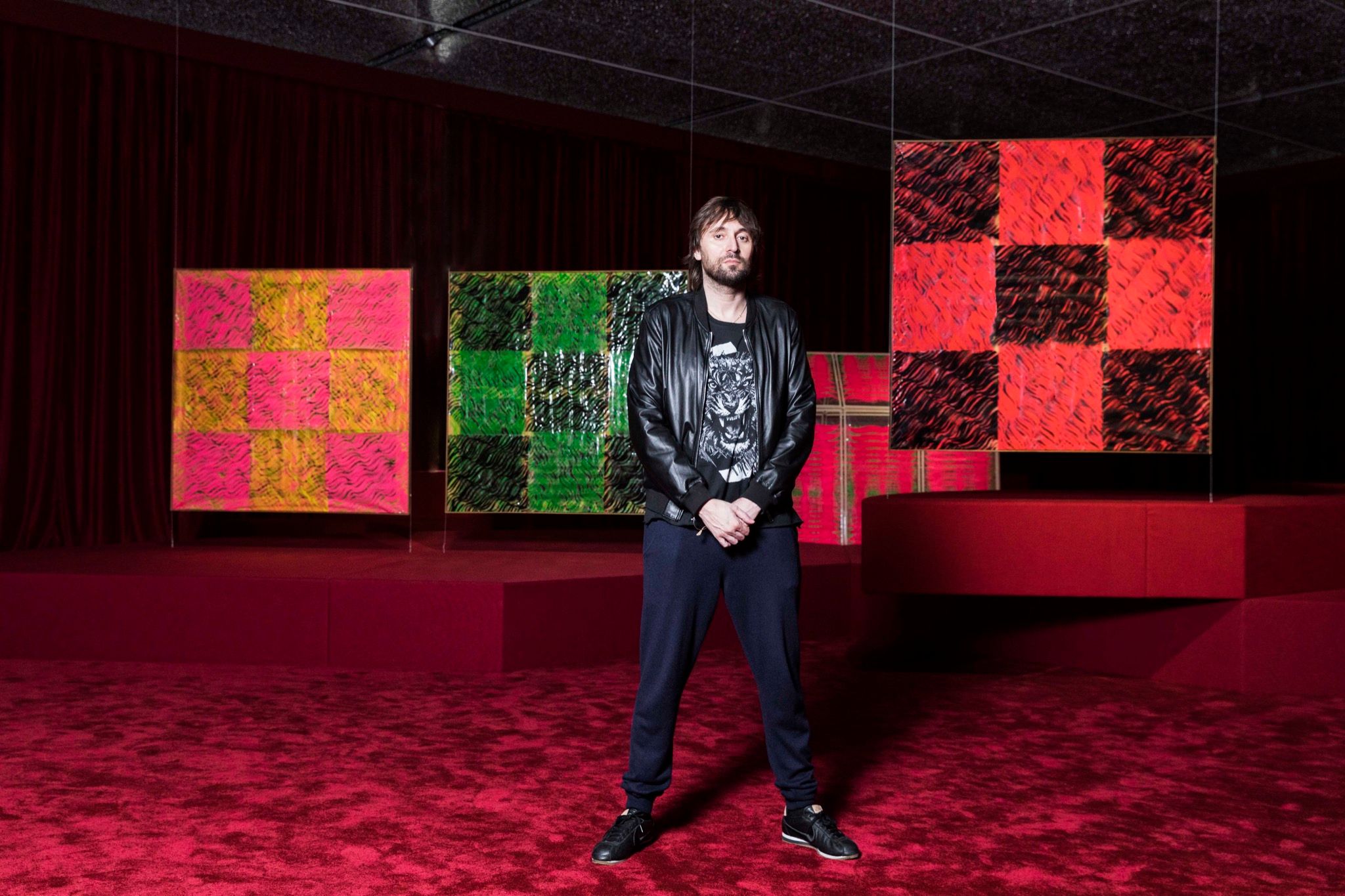In a Perpetual Now: ROSA BARBA at the Neue Nationalgalerie
|Victoria Camblin

Berlin’s Neue Nationalgalerie – Mies van der Rohe’s last project, and perhaps his most representative – reopened on August 22 after a six-year closure and facelift by David Chipperfield Architects. On view celebrating the museum’s much-anticipated revival are early 20th century selections from the permanent collection, a grand showing of sculptures by Alexander Calder, and In a Perpetual Now, a new site-specific project by Rosa Barba incorporating film and sculpture dating from 2009 to the present. Barba is the first contemporary artist to exhibit in the space since it closed for renovation in 2015, a makeover prefaced in late 2014 by an installation of 144 tree trunk “columns” designed by Chipperfield for the museum’s open glass central hall, and a Jake and Dinos Chapman show called “My Giant Coloring Book.” Berlin’s cultural landscape and identity have changed in the intervening years as the city has grown more dense, more expensive, and more diverse – and as public protests have called for rent control, climate action, and a de-colonial street map. Architecture, said van der Rohe, “is the will of an epoch translated into space,” but updating what the 1960s edifice has to say today falls to the contemporary artists exhibiting there, not its restorers.

Representing “the contemporary” on a platform as visible and ostensibly conservative as the Neue Nationalgalerie is a challenge both critical and architectural. The building is notoriously imposing on the art inside it and on the street below, above which it towers, temple-like, its glazed façade an impenetrable monument to modernist expression. Barba, whose solo show at Esther Schipper gallery is on view through August 28, 2021, occupies an exhibition space on the building’s lower story, which houses the museum’s permanent collection. The proximity that befits the artist’s interest in museum storage, the architectural, archival, and psychological function of which are addressed by several works on view. Her approach to the “now” faces the building’s legacy head-on, and from within. A steel structure built in reference to an earlier, unrealized Mies van der Rohe design provides a framework for a cinematic “montage” of 15 works: one brand new, the others recontextualized by and in response to the space, a Mies within a Mies. This doubling is another motif in Barba’s oeuvre, which uses image, text, and sound to create a language in which signifiers float between works, lending themselves to interpretation in dialogue both with their environment, and among themselves. In an immersive loop of roughly one hour, projectors turn on and off, beaming films onto two-sided screens, lighting up other objects, and functioning as kinetic sculptures. “I’m interested in film and its devices as tools, as instruments,” says the artist, whose individual works here become active participants in a symphonic, sometimes unruly composition.
One such participant is Plastic Limits – For the Projection of Other Architectures (2021), a film shot in and around the Neue Nationalgalerie in the years it stood empty. For the soundtrack, Barba wrote a brief line of music on the piano and invited Berlin musicians – including Peaches and Jan St. Werner – to interpret it. The arrangements vary so much from each other that one cannot identify the original leitmotif, making for an effective illustration of Barba’s point about the multiplicity of meaning. What Barba seeks – with her fusional approach to things archival and “new;” flat and three-dimensional; or seen, heard, and interpreted – is a diffusion of linearity, in both space and in time. She plans this escape from Cartesian thought and form using the system’s own geometric vocabulary, playfully looped and rephrased. How the resulting story, as an epochal “translation,” resolves is left open to interpretation. As the museum is narrated – reflected back onto itself, just as its glass exterior mirrors Berlin’s image back onto the city outside – the future of the institution dissolves into the depths of its archive.

Victoria Camblin: The Neue Nationalgalerie is notoriously “difficult” to exhibit in because the building is so dominant. How did you approach the architecture, and how did the building’s legacy impact what you chose to exhibit there?
Rosa Barba: My solo exhibitions always engage with the architecture and history of the building. I try to work out how the show can somehow expand to the exterior, or reflect the exterior within the interior space, so there’s always a conversation going on. For this show I decided to look at ideas that the building’s architect, Mies van der Rohe, never realized. I discovered designs for a building similar to what was eventually realize for the Barcelona pavilion and took them as a blueprint, translating the floor plan of this unrealized building into a horizontal stage for my pieces, which are installed at different heights within that space.
The Neue Nationalgalerie – which is seen as an ideal representation of Mies’ approach – was itself the result of adapting plans for other projects that hadn’t been realized, one in Cuba and one in Germany.
I’m always interested in histories that are invisible, or somehow embedded in things that have since acquired another function. I wanted to have a dialogue with this building, but also have a broader conversation using the vocabulary of the building – the language of its size and frame, for example. When I was researching that, I also found that Mies had a connection to experimental film, which is not such a focus when one thinks about him. There was this whole idea about rhythm that he was trying to translate from the early avant-garde films of Hans Richter, which he would use as a methodology for thinking about architecture. The idea of hidden history also relates to this film work – which hasn’t made it into the archive, hasn’t been integrated as something of value. I am interested in bringing those historical threads together with my films.
My relationship to the Mies’ building really begins more than a decade ago, before the Neue Nationalgalerie collection was even moved to an external depot. In 2010, I began a piece called Hidden Conference, which is a series of three films shot in museum storage spaces. I had been invited by the Reina Sofia Museum in Madrid to curate an exhibition with pieces in their collection, approached from an artist’s perspective. I decided to create a “conference” of pieces, taking away their authors and just thinking about the works and how they would engage in a discussion among themselves – even if they were produced in different times. The project evolved into an interest in producing films in museum storages, and I shot the first one at the Neue Nationalgalerie – a building I knew quite well, of course, from living in Berlin. I remembered visiting the museum when the doors going downstairs to the storage were open and you could see the older pieces there, totally uncrated, just sitting on shelves across from each other like modern sculptures in a surreal waiting room.
I shot the second video in that series at the Musei Capitolini in Rome. The collection was held in a very tall building with a 360 degree all glass rotunda, where ancient Roman sculptures with fragmented body parts stood overlooking the city. The third was shot at the Tate, London, and took several years to finally realize. There were problems with access, getting into the storage, but then we had to deal with image copyrights and what items in the collection could be reproduced in the film.
These are themes that came up in my recent interview with Clémentine Deliss: the value and psychology of museum collections and archives; the function of stored materials hidden from view in museum basements; and how, when, and why to make them public. Having seen a number of museum storage spaces, did you notice consistencies or differences between institutions or localities in terms of how objects are stored, displayed, cataloged, prioritized?
Of course, the three storages were so completely different – the Tate Modern’s facility at Elephant and Castle is a science fiction-like environment with perfect shelfing and cooling systems and various little rooms and giant water locks. In Rome, it was like nobody knew what is up there. My films always have a sound layer, and in the Tate film it consists of interviews with artists – some who are in the collection, others who are not. What I was trying to do was make an invisible introduction to the collection: when you hear XXXX’s voice echoing in the space, which does not contain one of her works, she is introducing the collection through its absences.
Another 35mm film I’m showing at the Neue Nationalgalerie is in some way a storage or depot film, but it’s about the Library of Congress in Culpeper, Virginia. In that film, I’m thinking about a kind of archive that is not put into discussion by curators. It’s a sort of bank, just there stockpiling as much cultural output as possible in very compressed forms, on every imaginable type of recording and storage devices used to hold all kinds of media. I juxtaposed that storage format with images I took in the Mojave Desert, documenting light production sources and poles used in electricity farms – tools like solar panels. The idea is to bring together these archives of light and energy with archives of compressed knowledge, creating a sort of white noise. When I’m looking at the function of the archive, I’m also looking at the effects of time on transforming these ideas.
The topic of time is interesting given the current global situation and how that has shifted our perception of time and how we inhabit its passage. Archives serve to document a linear time scale that seems less pertinent to our current experience today. There is a political dimension to archives, too – to what gets preserved and exhibited, to where the contents come from. Why are we archiving these works and objects – be they contemporary artworks, artifacts from around the globe, or in the case of the Library of Congress, recordings of television shows and other cultural ephemera? Is that something you are thinking about when you are working with them?
I mean, nobody’s really working with these archives, and that’s the thing I’m pointing to as well. Because it is really another colonial approach, this idea of getting as many things as we can and owning them. From Source to Poem starts with a caption describing the Library of Congress Packard Campus building: what it was meant to be for, how much it cost to build, and so on. My films always have a textual component, and the idea here was to draw the museum’s connection to what banks do, basically. It’s not just about materials – the Library of Congress collects personal stories, stories from people that have lived in the United States over time. It’s also about owning those experiences, and displacing them, making them part of the territory.


The Neue Nationalgalerie is not an apolitical space. Whatever is exhibited there is imprinted with that national context, the post-war West German cultural context, and so on – the building’s contents will be magnetized with the history of the space.
Well, Plastic Limits addresses this directly. It is a kind of “definition film,” about what architecture could be and what film itself could be. Texts appear on the side of the film frame, providing a definition system – something I’ve used in other work – a lexicon, a fictional library of terms. I shot a lot of the building, which I’m using as a sort of a projection device onto which the city is reflected. I also included footage I shot in the museum some years ago, when the building had been gutted and inside was a deserted space. The title refers to the plasticity of film, but also of architecture.
Are your use of text in film and your exploration of vocabularies also ways of dissecting archival practices, of looking at how things are cataloged and categorized?
Language is often used in cataloging, in narrating the archive, but I’m always trying to figure out new ways of using text, of making it explode its own function. It’s very interesting to me to bend language, to twist it in a direction that makes it mean something completely different. That’s why I use it in my films: a description starts with a sort of fact, but then it stretches into a possibility, and soon the Library of Congress becomes the Library of Babel. At some point, we don’t really know where we are anymore, because these words have created a new kind of hybrid possibility in the space of the archive. With the film Bending To Earth, which I made about the uranium sites in the desert in Utah and Colorado, the raw material is also a sort of archive – an archive of something that preexists even our notion of time.
The voiceover here also begins by describing the site – what materials it consists of, what kind of toxic mixes and gravel are there. The text starts out like a caption of a sculpture or painting describing the materials used and stating its date, then turns into a consideration of time itself.
So it’s like a geological catalog – layers of sediment and earth mirrored in the basements of museums, but also in the layered structure of your films, and in the layers of information and objects kept in museum storages? You use feedback loops, too, which have a way of interacting with, or maybe resisting, our notion of linear time – a notion which, frankly, I’m completely “over” since the pandemic. Your exhibition title, “In a Perpetual Now,” I suppose reflects this.
In 2021, I made a film called Time As Perspective, which was about treating time from a geological perspective and seeing it as layers on top of each other, instead of as a horizontal line. For Aggregate States of Matters (2019), which I shot in Peru, I was working with an indigenous community to film the transformation of the landscape and how the melting of the glacier impacted their lives. I followed along when they walked to make an offering to the glacier, and what intrigued me was that for this community, there was never a linearity to the concept of time. It was always a geological concept. Western history has made time into linear stretch to maintain an idea of effectiveness or progress. But how the world is changing right now, with climate crisis and with the pandemic, it doesn’t work anymore to think like that. I made several trips to Peru and spent a lot of time there filming, but I don’t specify where it was shot in the work, because I’m interested in examples of things we are dealing with everywhere. The reason I chose this location is because it’s the most condensed place in terms of having these environmental extremes – you have glaciers next to desert; you have a large indigenous population that has had to adapt to the conditions. I was interested in the knowledge that is still embedded there, and in seeing if there is a way of using the camera to get in touch with that and with each other – to open up new space.
Another part of my work for the last few years has been exploring a connection between film and astronomy, which often use the same devices and terminologies. I started researching the work of Henrietta Leavitt, a Harvard Observatory “computer,” as these women were called, who discovered how to use stars’ flickering as a way of calculating their distance from Earth – as measuring sticks for the universe. Observing the flicker – which is also a film term – she was able to show that the universe was much larger than we thought. For me, that relates to the expansion of possibility and the speculation that film can do.
So film, like these flickers of light in time, is also a tool of measurement for something unmeasurable?
For something expandable. I have never believed in these closed cinematic spaces, where you are meant to have this directional viewing situation. I’ve always imagined a spatial idea of cinema. Going back more than 20 years ago now, I was also was very much involved with contemporary dance and theater. And with my exhibitions, I am creating a frame, a set in which a sort of choreography happens.
I was invited to Cyprus seven years ago by an institution there, Point Art Center in Nicosia together with Mirjam Varadinis, and I was very intrigued by the border zone and the separation of the island. I found this one location, an austere field, where you see a mosque on one side and a church on the other, and I proposed to build an open-air cinema there, where people from both sides could access the same films, without border controls. I designed a kind of amphitheater – a circular shape, to come back to the idea of the loop – with a screen at the center. In my exhibitions as well, you usually see the film from both sides. Because it is the first ever structure since 1974 to be put in that zone, I didn’t want to impose something that would stay forever. It’s made of rammed earth, of earth that is already there. The whole stage is also the seating. The only imposition is the frame with the screen, which can then be taken away. So, this project is also about time: how long will it last until it deteriorates and goes back into the earth? And will there be enough time for it to do its job, for people to come together and use it as a space to share?




Artists have tried to work across the border in Cyprus before. Manifesta, the “European biennial,” tried back in the 2000s. They didn’t pull it off – they opened a project space in Berlin instead. It’s interesting to hear that now, an ambitious cultural project is going through.
If anything, it’s maybe gotten worse now, with the political situation in Turkey. When we proposed the project to the Italian cultural council, they funded it, but then we still didn’t have the okay from the United Nations. The Italian ambassador helped to mediate, and we partnered with Greek and Turkish organizations. When we got the okay, I couldn’t believe it. There were several times when we were building it that I thought, “Well, we have to stop the construction.” With the right-wing government on the Turkish side, they didn’t want to do it, and during Covid they wanted to take it down again. But now finally it’s built!
Filmmakers and artists from the north and the south will form a board to think about how to run the space in the future, and I have invited them to show their works when I screen my film there, so it will be a little festival. We will also involve young filmmakers and children in workshops. It should be a space for schools, for everyone. There are communities that cannot cross into the border zone, for example refugees from Syria living there, so now we have to create a sort of artist visa system that allows access, so you can go watch your film. What was super beautiful in the meetings with the UN and all the representatives was that at some point they just said, “Look, what we have learned here since the 1970s, as artists, is that the only way is to make little changes.”
How do you connect this upcoming project to what you’re showing this month in Berlin?
Of course, in Cyprus, the project is sitting in a border zone, in a contested space, and so it has a more directly political positioning. But I always try to turn and move perspectives in my films, and I see this as something fundamentally political, too. However explicitly, shifting narratives brings certain things to the foreground, puts them in a new light.




Credits
- Interview: Victoria Camblin
Related Content

Exhibition and Empire: Decolonizing Museums Requires a New “Metabolic” Architecture, Says Curator CLÉMENTINE DELISS

“The ultimate form of being outside of anything is death. Then you’re really free.” Société de 032c Presents: STEFAN KALMÁR

LOVE! INSTAGRAM! COMPASSION! Between an Ipanema bikini and an over-decorated cake, FRANCESCO VEZZOLI's Love Stories